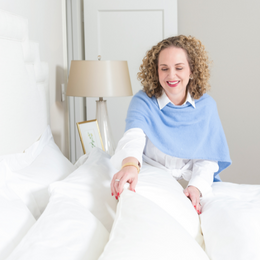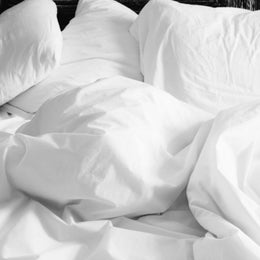We all spend a lot of time in bed, so naturally, we want to make those beds as comfortable and cozy as possible. Most of us don’t consider the huge impact that the quality of the sheets we sleep in can have on our rest. There are fundamental differences in bedding quality, but not many of us really know what we’re looking for--or even what we’re looking at--when we shop for linens.
Let’s start with the basics and one of our favorite things: percale sheets.
What Is Percale?
To understand what makes percale sheets unique, you first need to know how woven fabrics are produced. All woven, non-stretch fabrics are made of the same basic building blocks of intersecting perpendicular threads. That warp (the threads moving lengthwise) and weft (the threads moving widthwise) meet to make up the fabric’s weave.
Percale sheets are distinguished by the fact that every single warp thread alternately crosses over and under every single weft thread. This percale weave is sometimes called a balanced or closed weave thanks to the 1:1 ratio of warp and weft threads, yielding a tight, durable weave.

Now imagine that general pattern, but instead of weaving together in a continuous over-under pattern, each thread passes over three threads for everyone that it goes under. This weaving 3:1 produces sateen sheets.
Now that you’ve got the percale versus sateen composition basics down let’s take a closer look at four of the most significant benefits that percale sheets offer.
Percale Durability
The crisscross pattern used to produce percale has a huge impact on a sheet’s lifespan. Simply put, percale sheets will outlast sateen sheets every single time. Percale’s tighter weave gives the sheet more durability, making it less susceptible to tears, fraying, and other signs of age. By contrast, the threads in a sateen sheet are made in an imbalanced weave, which gives the sateen fabric significantly less strength and stability.

Resistant to Pilling and Snags
Even before a sateen sheet starts to fall apart, you’re likely to see signs of wear and tear. Because the face of sateen fabric runs primarily in one direction, the surface threads are far more exposed, and that leads to more snagging, pilling, and fraying. On the other hand, Percale’s tight weave helps to protect the fabric against those common problems.
Get Softer With Age
The producers of sateen sheets love to tout the fabric’s naturally soft feel. While it’s true that sateen will initially feel smooth to the hand, the fabric is quick to take on a limp, uneven feeling after a few trips through the washer. That’s the trade-off with the imbalanced nature of the weave. Percale, meanwhile, can easily stand up to repeat launderings and will actually get softer as it ages.
Naturally Lightweight and Breathable
In order to compensate for sateen’s weaker nature, manufacturers are often forced to use heavier thread gauges. As a result, sateen sheets tend to weigh significantly more than percale sheets. Likewise, sateen sheets are often far less breathable than percale, increasing the chances that you’ll find yourself waking up hot in the night.

The structural durability of percale weave allows manufacturers to use lighter (read: more breathable) gauges of thread. Percale sheets will always make the better choice for year-round comfort and those who tend to sleep hot.
Misconceptions
Have you been on the receiving end of misinformation about percale? Let’s set the record straight about three of the most common percale myths in the world of luxury linens.
Myth # 1: Percale is not Cotton
Perhaps the most common source of confusion about percale has to do with the material from which it’s made. In fact, the term percale is not used to reference any one particular material specifically. Instead, percale simply identifies the weave pattern used to construct a fabric. Percale sheets may be made from cotton, polyester, or even naturally-derived bamboo fibers. While the type and quality of the material will certainly play a role in the feel and performance of the sheet, most of the wonderful benefits associated with percale sheets come directly from the way they are crafted.

Myth # 2: Percale Sheets are Rough
Die-hard sateen fans will often claim that percale sheets are rough or uncomfortable compared to sateen sheets. Percale sheets indeed have a crisper hand feel than the silkier fish on a sateen sheet, but that’s only true while they’re new. The inverse proves true once you start living in your sheets: percale is the softer, more comfortable, and lasting option.
That said, any sheets--including sateen sheets--may feel rough and scratchy if they’ve been made from inferior quality materials. In addition to the weave, the key here is the length of the fibers used to create the sheet. Long-staple cotton, like that used in our percale sheets, is infinitely softer than short-staple cotton, regardless of the weave pattern.
Myth # 3: Percale Sheets are Lower Quality than Sateen
If you’ve heard this claim, it’s likely to be coming from someone looking at thread count and nothing else. It’s important to realize that the thread count for percale and sateen sheets can vary across the board. It is perhaps just as valuable to acknowledge that a sheet’s thread count doesn’t tell the whole story when gauging a sheet’s quality.
In fact, a common strategy among manufacturers of cheap sateen sheets is to drastically increase the thread count in an attempt to distract customers from the sheets’ poor quality in other regards. Instead of falling for marketing magic, pay attention to the quality of the materials used. That’s where Thomas Lee shines.
Sleep well!




